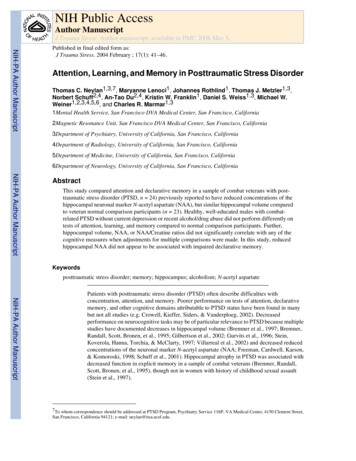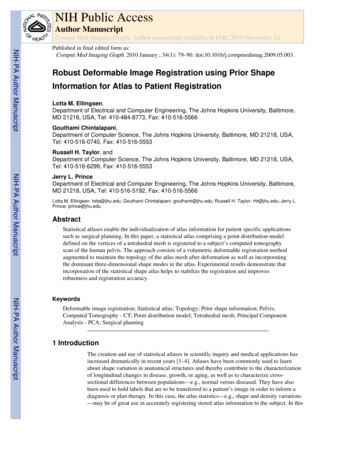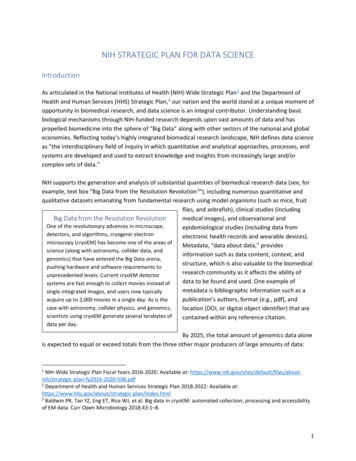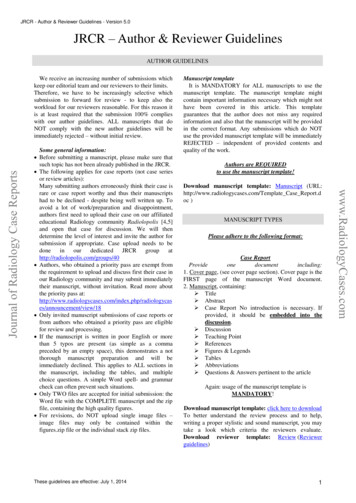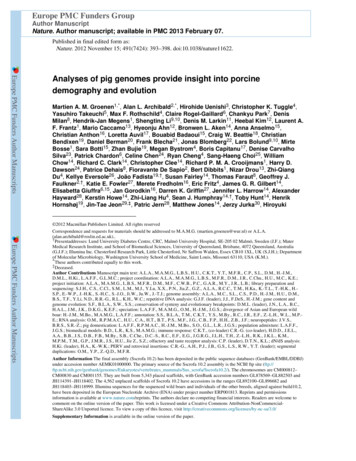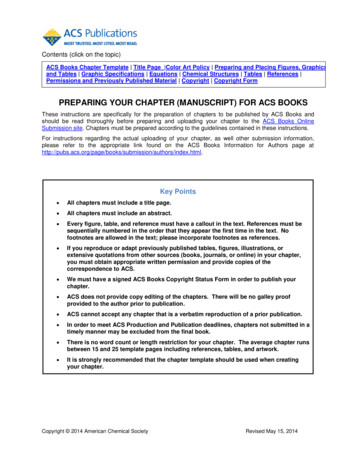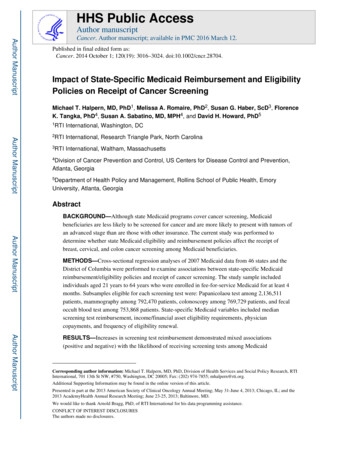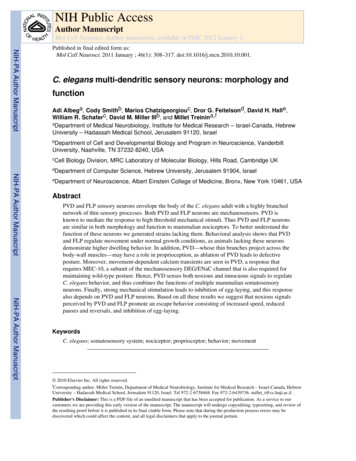
Transcription
NIH Public AccessAuthor ManuscriptMol Cell Neurosci. Author manuscript; available in PMC 2012 January 1.NIH-PA Author ManuscriptPublished in final edited form as:Mol Cell Neurosci. 2011 January ; 46(1): 308–317. doi:10.1016/j.mcn.2010.10.001.C. elegans multi-dendritic sensory neurons: morphology andfunctionAdi Albega, Cody Smithb, Marios Chatzigeorgiouc, Dror G. Feitelsond, David H. Halle,William R. Schaferc, David M. Miller IIIb, and Millet Treinina,faDepartment of Medical Neurobiology, Institute for Medical Research – Israel-Canada, HebrewUniversity – Hadassah Medical School, Jerusalem 91120, IsraelbDepartmentof Cell and Developmental Biology and Program in Neuroscience, VanderbiltUniversity, Nashville, TN 37232-8240, USAcCellBiology Division, MRC Laboratory of Molecular Biology, Hills Road, Cambridge UKNIH-PA Author ManuscriptdDepartmentof Computer Science, Hebrew University, Jerusalem 91904, IsraeleDepartmentof Neuroscience, Albert Einstein College of Medicine, Bronx, New York 10461, USAAbstractNIH-PA Author ManuscriptPVD and FLP sensory neurons envelope the body of the C. elegans adult with a highly branchednetwork of thin sensory processes. Both PVD and FLP neurons are mechanosensors. PVD isknown to mediate the response to high threshold mechanical stimuli. Thus PVD and FLP neuronsare similar in both morphology and function to mammalian nociceptors. To better understand thefunction of these neurons we generated strains lacking them. Behavioral analysis shows that PVDand FLP regulate movement under normal growth conditions, as animals lacking these neuronsdemonstrate higher dwelling behavior. In addition, PVD—whose thin branches project across thebody-wall muscles—may have a role in proprioception, as ablation of PVD leads to defectiveposture. Moreover, movement-dependent calcium transients are seen in PVD, a response thatrequires MEC-10, a subunit of the mechanosensory DEG/ENaC channel that is also required formaintaining wild-type posture. Hence, PVD senses both noxious and innocuous signals to regulateC. elegans behavior, and thus combines the functions of multiple mammalian somatosensoryneurons. Finally, strong mechanical stimulation leads to inhibition of egg-laying, and this responsealso depends on PVD and FLP neurons. Based on all these results we suggest that noxious signalsperceived by PVD and FLP promote an escape behavior consisting of increased speed, reducedpauses and reversals, and inhibition of egg-laying.KeywordsC. elegans; somatosensory system; nociceptor; proprioceptor; behavior; movement 2010 Elsevier Inc. All rights reserved.fCorresponding author. Millet Treinin, Department of Medical Neurobiology, Institute for Medical Research – Israel-Canada, HebrewUniversity – Hadassah Medical School, Jerusalem 91120, Israel. Tel 972-2-6758468. Fax 972-2-6439736. millet t@cc.huji.ac.il .Publisher's Disclaimer: This is a PDF file of an unedited manuscript that has been accepted for publication. As a service to ourcustomers we are providing this early version of the manuscript. The manuscript will undergo copyediting, typesetting, and review ofthe resulting proof before it is published in its final citable form. Please note that during the production process errors may bediscovered which could affect the content, and all legal disclaimers that apply to the journal pertain.
Albeg et al.Page 21. IntroductionNIH-PA Author ManuscriptIn mammals, the somatosensory system is responsible for diverse sensory modalitiesincluding responses to touch and temperature, maintenance of body posture(proprioception), and the feeling of pain (nociception). These neurons perceive stimuli to theouter layer of the body (skin) or to internal organs (Lumpkin and Caterina, 2007).Nociceptors are an important class of somatosensory neurons perceiving high-thresholdmechanical stimuli, noxious temperatures, and/or tissue damage. Mammalian nociceptorsare typically highly branched with multiple naked sensory dendrites (Caterina and Julius,1999). Nociceptors showing similar morphology and function are seen in Drosophila,providing evidence for conservation of this cell type throughout evolution (Tracey et al.,2003).C. elegans is a useful model organism with a simple, well-characterized nervous system.The C. elegans nervous system has 302 neurons, including sensory neurons that aremorphologically similar to somatosensory neurons in having dendritic processes positionedimmediately underneath the nematode hypodermis or “skin.” These neurons aremechanosensory, enabling the response to low threshold mechanical stimuli (the six touchreceptor neurons), to bacteria (PDEs), or having a role in proprioception (DVA) (Chalfie andSulston, 1981; Sawin et al., 2000; Li et al., 2006).NIH-PA Author ManuscriptComprehensive analysis of C. elegans neuroanatomy by electron-microscopy demonstratedthat most C. elegans neurons adopt a simple morphology with few branches (White et al.,1986). Our work, however, revealed that PVD neurons are atypical for the nematode, anddisplay elaborate dendritic branching (Halevi et al., 2002; Oren-Suissa et al. 2010; Smith etal., 2010). PVD was previously shown to mediate the response to high threshold mechanicalstimuli and thus functions as a nociceptor (Way and Chalfie, 1989). This function of PVDtogether with the high complexity of PVD branching and position of PVD branches belowthe outer envelope of the animal are characteristic of mammalian poly-modal nociceptors(Caterina and Julius, 1999). Indeed, recent analysis of PVD activity and function shows thatPVD senses both cold temperature and high threshold mechanical stimulation(Chatzigeorgiou et al., 2010). Thus, PVD is similar to mammalian and Drosophilapolymodal nociceptors in both morphology and function (Tracey et al., 2003).NIH-PA Author ManuscriptHere we characterize the structure and the functions of PVD and of a related sensory neuron,FLP. Our results show that PVD and FLP branches envelope the animal with a densenetwork of dendritic processes producing non-overlapping sensory fields, with the PVDnetwork restricted to the body and tail regions and FLP branches surrounding the head. Weshow that both PVD and FLP dendritic branches appear simultaneously during late larvaldevelopment, although FLP neurons are born in the embryo and PVD neurons arise in thesecond larval stage. We suggest that noxious signals perceived by these neurons mediate anadult escape behavior consisting of increased speed, reduced reversals and pauses, andinhibition of egg-laying. We also show that PVD branches overlay body muscles withmultiple sensory processes and suggest that these branches have a role in proprioception.Thus, side branches of PVD and FLP neurons combine multiple roles, perceiving bothnoxious and innocuous signals, to promote an escape behavior or to regulate body posture.2. Materials and Methods2.1 Imaging of PVD and FLP morphologyAnti-DEG-3 antibodies and DEG-3 staining methods were utilized as previously described(Yassin et al., 2001). The F49H12.4:GFP reporter for visualizing PVD was previouslydescribed (Watson et al., 2008). A mec-7:RFP reporter was utilized to visualize FLPMol Cell Neurosci. Author manuscript; available in PMC 2012 January 1.
Albeg et al.Page 3NIH-PA Author Manuscriptmorphology (Hamelin et al., 1992). The body wall muscle marker was myo-3:dsRed2 (Fireand Waterston, 1989). TEM analysis was undertaken principally on serial section images ofthe archival animal “N2U” provided from the MRC collection of John White and JonathanHodgkin. Additional studies were done on other wild type adult animals in the Hall archives.Many serial images of animal N2U can also be viewed on the websitewww.wormimage.org. Click on the N2U “color code” to see some of the codes assigned tofine branches of FLP and PVD by Eileen Southgate and John White.2.2 Generation of transgenic lacking PVD and FLPTo enable killing of neurons we used a 3.2 Kb genomic fragment starting from the deg-3ATG, containing the entire deg-3(u662) (DEG-3-N293I) coding region and 3′ untranslatedregion sequences (Treinin and Chalfie, 1995). This fragment was inserted downstream of a4.1 Kb ser-2prom3 promoter fragment (Tsalik et al., 2003), or a 2.4 Kb mec-10 promoterfragment (Huang and Chalfie, 1994). These constructs were injected at 5ng/μl together withdpy-20 DNA (20ng/μl), and SKII (100ng/μl) to dpy-20(e1282) animals. Transgenes wereintegrated into the genome using UV (Mitani, 1995) and out-crossed before analysis.2.3 Movement and posture analysisNIH-PA Author ManuscriptAnimals for movement and posture analysis were picked as L4 to fresh plates and grownovernight to adulthood at 20 C. For image analysis single adults were picked to a freshNGM plate (pre-equilibrated at 20 C) having a thin layer of OP50 (overnight growth) andallowed to acclimate for 10 minutes at 20 C. Movement of each animal was then recorded ata 25X magnification and at a rate of 10 frames per second. Animals were recorded for 60seconds or until they moved out of the frame. These movies were analyzed using softwaredeveloped for this purpose (detailed description of this software is provided inhttp://www.cs.huji.ac.il/ feit/worms/usermanual.pdf).NIH-PA Author ManuscriptIn brief, the animal was identified using a threshold on grey levels and then a skeleton(central line) was generated for each frame. The head was identified automatically andchecked for consistency across frames; this was then verified manually. Movement in eachframe was identified as forward (movement of the skeleton’s midpoint towards the positionof the head in the previous frame), backward (reversal, movement of the midpoint awayfrom the position of the head in the previous frame), pause (mid-point movement of lessthen 0.05 mm/sec), or omega turn (when a straight line connecting the head and tail does notintersect with the skeleton except at the ends and the maximal amplitude is 40% of theskeleton length). Consecutive frames having the same type of movement form a singlesegment. Thus, we could quantify the number of segments of each type of movement, thetime spent in different types of movement, and attributes of movement such as speed andposture for each type of movement.Speed is an average in mm/sec for all frames of forward or backward movement.Displacement is the net distance in mm traversed by the animal’s centroid in the first 15seconds of the movie. Only a few animals escaped the frame within less than 15 seconds; inthese cases the displacement used is the distance traversed by the centroid between the firstand last frame analyzed. Therefore, the net displacement was normalized by dividing by theduration (in seconds) of the analyzed segment. This measurement integrates information onspeed, percentage of time spent in pauses, and rate of reversals, as each of these factorsaffects the average net displacement per second.Cut point number is the number of times the worms’ skeleton intersects with a straight lineconnecting the animal’s nose to its tail, including the end points. As pixels are discrete,“intersection” means a distance from the skeleton of less than a pixel. A sequence of 3 orMol Cell Neurosci. Author manuscript; available in PMC 2012 January 1.
Albeg et al.Page 4more skeleton points at a distance of more than 1.4 pixels (the diagonal of a pixel, needed toaccount for possible variations in orientation) is required between successive cut-points.NIH-PA Author ManuscriptAverage bending angle is a measure of the curvature along the worm. Angles are measuredfrom the head towards the tail, and are in the range of 180 , indicating an inclination to theleft (positive) or to the right (negative). Angles are measured as follows. Consider threeskeleton points a, b, and c. The angle at point b is the angle between the continuation of theline from a to b and the line from b to c. Thus if the worm is completely straight, the anglewill be 0. The distances from a to b and from b to c are one twelfth of the skeleton length(see figure 4A for a diagrammatic representation). The average bending angle is the averageof the absolute values of the angle as measured for all skeleton points, except within onetwelfth of the length from the ends. Avoiding the ends reduces the effect of foragingbehavior. Due to using the absolute values, positive and negative angles (inclination to leftor right) do not cancel out.Average amplitude is the average distance in pixels from each point in the skeleton to theline connecting the nose and the tail. Postural parameters (bending angle, cut-point number,and average amplitude) are taken from segments of forward movement. To eliminatedifferences in amplitude that are a result of skeleton length, the average amplitude wasdivided by the skeleton length (mm) to produce a normalized average amplitude.NIH-PA Author ManuscriptWavelength is ill-defined for many of the frames, as the worm shape does not resemble asinusoidal posture (see supplemental figure 4). We therefore use the following procedure toboth identify frames where the posture is wave-like and find the wavelength. First, wesmooth the angles by averaging over a window of 3 in either direction. Then we find theminimal and maximal signed angle on either side of the worm’s midpoint. The wavelengthis the distance between the skeleton points with the two maximal angles, or the points withthe two minimal angles, subject to the requirement that maximal or minimal angles used alsohave an absolute value of more than 13 . Otherwise, the wavelength is not defined for thisframe. If both maxima and both minima have an absolute value of more than 13 , the pairwhere the smaller absolute value is larger is selected. Note that with this definition thewavelength is the straight distance between two extremum points, similar to theconventional physical definition of wavelength, but different from the definition used byKorta et al. (2007) who measured the length along the worm’s skeleton. The normalizedwavelength is the wavelength divided by the skeleton length.NIH-PA Author ManuscriptFor (normalized) average amplitude and angle the average is first calculated for all theskeleton points in each frame of forward movement. Then the median of these averages isfound using all such frames in each movie. Finally, the value reported in figure 4 is theaverage for all movies from the same strain. Numbers are average standard error of means.Statistical analysis was done using Anova with the Bonferoni correction using Origin 7.Odata analysis package.2.4 Calcium ImagingOptical recordings of PVD performed as described (Chatzigeorgiou et al., 2010) on a ZeissAxioskop 2 upright compound microscope equipped with a Dual View beam splitter and aUniblitz Shutter. Fluorescence images were acquired using MetaVue 6.2. Filter-dichroicpairs were excitation, 400–440; excitation dichroic 455; CFP emission, 465–495; emissiondichroic 505; YFP emission, 520–550. Individual adult worms ( 24h past L4) were gluedover the entire length of their body or partially glued around the tail region with NexabandS/C cyanoacrylate glue to pads composed of 2% agarose in extracellular saline (145 mMNaCl, 5 mM KCl, 1 mM CaCl2, 5 mM MgCl2,20 mM D-glucose, 10 mM HEPES buffer,pH 7.2). Worms were allowed to freely bend in the saline. Acquisitions were taken at 10HzMol Cell Neurosci. Author manuscript; available in PMC 2012 January 1.
Albeg et al.Page 5NIH-PA Author Manuscript(100ms exposure time) with 4 4 binning, using a 63x Zeiss Achroplan water immersionobjective. Approximately 3000 frames were captured. Calcium peaks were analyzed usingcustom made software. The ratio change percentage was calculated as R/R0 as described in(Kerr et al., 2000).2.5 Egg-laying assaysFor egg-laying assays L4 animals were picked to fresh plates for overnight growth toadulthood. For experiments, individual adults were picked to fresh plates using a wire pickand the number of eggs laid was counted half an hour and 2 hours following transfer. Theexpected number of eggs laid over half an hour period is obtained by dividing the averagenumber of eggs laid by a specific strain over a 2 hour period by 4.3. Results3.1 PVD and FLP neurons envelop the animal in a complex network of sensory processesNIH-PA Author ManuscriptPVD and FLP are both highly branched neurons ((Halevi et al., 2002) eurons). Analysis of reporters expressedin PVD but not in FLP shows that PVD branches envelop the entire body of the animal witha dense network of branches, a network that does not cover the head region (Tsalik et al.,2003; Watson et al., 2008). Similar analysis of the organization of FLP branches has beendifficult since reporters for FLP branches (deg-3, des-2, and mec-3) are also expressed in thePVD. Therefore, to examine the organization of FLP branches relative to PVD branches, weused F49H12.4:GFP to mark PVD and a mec-7:RFP reporter to mark both FLP and PVD. Inthis two-color animal, RFP marked-processes seen in the head resemble the elaboratenetwork of GFP-expressing PVD branches in the body region posterior to the pharynx (Fig.1). In addition to confirming that FLP and PVD neurons adopt similar dendriticmorphologies, our analysis revealed that these FLP and PVD networks occupy discreteregions and do not overlap (Fig. 1). Thus, side branches of the two FLP neurons (FLPL andFLPR) envelop the head of the animal (left and right sides), whereas the two PVD neurons(PVDL and PVDR) similarly ensheathe the body from the tail up to the head (left and rightsides). Overall this analysis suggests that the body of C. elegans is surrounded with a densenetwork of branches emanating from four neurons, each receiving inputs from a distinctsensory field that does not overlap with the sensory fields of the other three neurons.NIH-PA Author ManuscriptThe complexity of PVD and FLP morphology was unexpected in view of the relativesimplicity of other C. elegans neurons. Moreover, electron microscopy reconstruction of theC. elegans nervous system failed to document the full complexity of FLP morphology anddid not reveal any of the PVD side branches (2 , 3 and 4 as described in Fig. 1 (White etal., 1986)). However, reexamination of the archival C. elegans serial section prints used inthat study for evidence of these branches identified many processes in the position suggestedby the GFP reporters. These processes correspond to the dorsal and ventral 4 branches, andsometimes the short 3 processes from which the 4 branches emanate ((Oren-Suissa et al.,2010;Smith et al., 2010) and (Fig. 2B-D)).The 3 processes are similar in diameter and contents to many other neuronal processes inthe nematode (Fig. 2A and B), whereas the 4 processes are distinctly narrower, and almostdevoid of internal contents (Fig. 2B-D). Due to their very small caliber, it is difficult tofollow the course of 4 processes as they run beneath the body-wall muscles. In favorablecircumstances, a 4 process might be observed in three sections in a row. However, at themedial edge of each body-wall muscle quadrant, the 4 branches often turn to run in parallelto the body axis, adjacent to either the dorsal or ventral nerve cords (Fig. 2D). In these areas,the 4 branches can be followed for dozens of serial sections, and indeed some of them wereMol Cell Neurosci. Author manuscript; available in PMC 2012 January 1.
Albeg et al.Page 6NIH-PA Author Manuscripttraced by hand by Eileen Southgate and John White and assigned individual “color codes”for local portions (unpublished data from the MRC archive). However, since these processescould not be traced back to their cell of origin, none of these fine processes were included in“Mind of a Worm” (White et al., 1986) and their significance was missed. Interestingly,there are multiple instances where these 4 processes are fused to their nearest neighborswhile running along the A/P axis near the nerve cords, thus forming closed loops withneighboring candles in the “candelabra” [indicated in Fig 2A with arrows] and (Oren-Suissaet al., 2010).NIH-PA Author ManuscriptQuaternary (4 ) processes tend to retain the same small diameter (35–60 nm) along theentire length of each candle and near a nerve cord. These fine branches are neverpresynaptic, rarely postsynaptic, and show no evidence (so far) of forming gap junctions.This suggests that their many sensory endings must act in summation to influence distantsynaptic relations, rather than in local circuits. The 4 processes always lie in very closeassociation with hypodermis, seemingly separated from the overlying body-wall musclemembrane by the thick basal lamina. Using the head/body boundary to differentiate betweenPVD and FLP processes (since we still cannot trace them to their cells of origin), the 4 processes of both cell types have the same physical attributes and run in the same localebetween the body-wall muscles and the hypodermis. There was no evidence that processesfrom the left and right cells could interact with their bilateral homologue at either the dorsalor ventral midline. Dorsal fine processes of FLP seem to fuse more extensively than do PVDfine processes.Interestingly, electron microscopy suggests that 3 branches of PVD are positioned along theedge of the outer body-wall muscle quadrants and that branches emanating from PVDR andPVDL are positioned in a narrow space between the muscles and the outer hypodermis (Fig.2B-D). Confirmation of this model is provided by confocal images of a transgenic strainexpressing both F49H12.4:GFP (to mark PVD) and a muscle reporter (myo-3:dsRED2).Reconstruction of a Z-stack of confocal images clearly shows that PVD terminal branches(GFP) are closely apposed to the outside surface of each body-wall muscle quadrant (Fig.2E-P).3.2 Genetic ablation of PVD and FLP neuronsNIH-PA Author ManuscriptFor the purpose of exploring the behavioral roles of PVD and FLP, we generated transgeniclines in which these neurons are eliminated (Table 1). This was achieved using aconstitutively active version of the nicotinic acetylcholine receptor (nAChR) channelsubunit, deg-3(u662), which contains a I to N change at amino acid position 293 (or DEG-3I293N) (Treinin et al., 1998). For selective ablation of PVD, we used the ser-2prom3promoter to drive selective expression in PVD and OLL neurons (Tsalik et al., 2003). In thistransgenic line (ser-2prom3:DEG-3-N293I), PVD is specifically killed ( P). OLLs areunaffected by this transgene (supplemental Fig. 1), probably because the OLLs do notexpress DES-2, a nAChR subunit that is required for formation of functional DEG-3receptors (Treinin et al., 1998). Combining the ser-2prom3:DEG-3-N293I transgene withthe mec-4(e1611) degeneration-causing mutation (Driscoll and Chalfie, 1991) led to thekilling of PVD and the six touch receptor neurons ( TP). Last, expression of DEG-3-N293Ifrom the mec-10 promoter (mec-10p:DEG-3-N293I) led to the elimination of PVD, FLP,and the 6 touch receptor neurons ( TPF) (Huang and Chalfie, 1994). Analysis of thesestrains reproduced results of Way and Chalfie (1988), showing that PVD together with touchreceptors are required for the avoidance response to high threshold mechanical stimuli(harsh touch) to the mid-body (supplemental Fig. 2). This result demonstrates the highpenetrance of PVD and touch receptor degeneration in our strains as elimination of bothPVD and touch receptors is required for the harsh touch response (Way and Chalfie, 1989).Mol Cell Neurosci. Author manuscript; available in PMC 2012 January 1.
Albeg et al.Page 7Moreover, elimination of the mec-4 gene, and not of the touch receptors, does not eliminatehigh threshold mechanosensitivity of the touch receptor neurons (Suzuki et al., 2003).NIH-PA Author Manuscript3.3 PVD and FLP sensory neurons regulate C. elegans movementWild-type C. elegans placed on agar (solid surface) move via propagation of a sinusoidallike waveform. Animals move constantly, mostly forward, namely head first. Thismovement is punctuated by short pauses and direction changes. These direction changes areachieved by short reversals, i.e. tail first (backwards) movement, or by sharp body bends –omega turns.NIH-PA Author ManuscriptVisual observation of strains lacking PVD and FLP suggested that the elimination of theseneurons altered overall movement. To quantify these defects, we recorded short movies ofsingle animals from each PVD and FLP-ablated strain ( P, TP, TPF) and used customdesigned image analysis software to compare them to video recordings from the wild-typecontrol (N2) and from mec-4(e1611) ( T). This analysis confirmed that the overallmovement of animals lacking PVD, FLP, and touch receptor neurons ( TPF) is significantlydifferent from that of wild-type animals (Fig. 3). Specifically, TPF animals are slower(Fig. 3A), pause more frequently (Fig. 3B), and make more reversals (Fig. 3C). Togetherthese differences lead to increased dwelling (decreased displacement) of TPF animalswithin a restricted area (Fig. 3D and E). These defects are unlikely to be a result of the lackof touch receptor neurons as T animals are similar to wild-type in all of the parametersexamined (Fig. 3). Effects on speed and number of pauses are likely to require eliminationof both PVD and FLP, as animals lacking only PVD ( P and TP) have an intermediatephenotype, between wild-type and TPF: speed in mm/sec of P and TP is 0.15 0.008and 0.14 0.009 relative to 0.19 0.008 and 0.11 0.005 for wild-type and TPF respectively,and number of pauses per frame of P and TP is 0.02 0.003 and 0.02 0.003 relative to0.011 0.002 and 0.035 0.002 for wild-type and TPF respectively (Fig. 3). Effects on thedisplacement and number of reversals, however, are likely to depend mostly on FLP, asstrains having intact FLP ( P and TP) are similar to wild-type. Although the PVD-lackingstrains ( P and TP) appear to show reduced displacement relative to wild-type, thisdifference is not significant and much smaller than the effect resulting from the combinedelimination of PVD, touch neurons and FLP ( TPF) (fig 3D). Together, the defects seen inanimals lacking PVD and FLP lead to increased dwelling within a restricted area andsuggest that PVD and FLP function to promote an escape response, as is seen in the harshtouch response. These results also suggest that PVD and FLP are active under normalgrowth conditions and in the absence of acute stimuli.NIH-PA Author ManuscriptGenetic analysis has established that the mec-3 transcription factor is required for themechanosensitive function of PVD and FLP (Way and Chalfie, 1988). mec-3 animals showoverall sluggish movement that resembles that of animals lacking PVD and FLP. Thissimilarity is strikingly confirmed by movement analysis, showing near identity betweenmovement defects of TPF and mec-3 animals (Fig. 3). It is interesting to note that mec-3 isrequired for the elaboration of the PVD dendritic arbor; in mec-3 mutants the PVD neuronsdisplay lateral primary (1 ) dendritic processes projecting along the each side of the animalbut not the side branches (2 , 3 , and 4 (Tsalik et al., 2003)). Thus, the movement defect ofmec-3 and TPF mutant animals is correlated with the absence of the PVD sensory network.mec-3 is also required, however, for expression of the MEC-10 DEG/ENAC ion channel(Huang and Chalfie, 1994) which was recently shown to mediate the response of PVD tohigh-threshold mechanical stimuli (Chatzigeorgiou et al., 2010). Interestingly, our analysisof mec-10(ok1104) animals does not show movement defects resembling those of eithermec-3 or TPF mutant animals (effects of mec-10 on speed and the number of pauses areopposite to those of TPF and mec-3 animals, Fig. 3A and B). Thus, defective mec-10dependent mechanosensation does not account for the movement defects shown in mec-3Mol Cell Neurosci. Author manuscript; available in PMC 2012 January 1.
Albeg et al.Page 8NIH-PA Author Manuscriptmutants. MEC-3, however, is required for expression of many additional genes (Zhang etal., 2002) in the touch neurons and could therefore drive expression of other functionalcomponents that are necessary for the normal roles of PVD and FLP in locomotion.3.4 PVD is required for maintaining normal body posture and responds to body bendingOur analysis of PVD morphology shows that PVD terminal (4 ) branches grow across themuscle quadrants (Fig. 2). The position of these branches in close contact with thecontractile apparatus seems well-suited to a potential role as a proprioceptor monitoringmuscle tension. If PVD neurons function as proprioceptors, their elimination should lead topostural defects, i.e., to changes in the waveform (shape) of animals lacking these neurons.To examine this possibility we quantified several parameters that characterize thenematode’s waveform. These metrics, described in Fig. 4A, were chosen as they do notdepend on the assumption that animals adopt regular sinusoidal movement. They are basedon drawing a skeleton (central line) along the animal’s body, and a straight line connectingthe nose to the tail. The number of points where the two lines intersect is the cut-pointnumber. The amplitude corresponds to the vertical distance from the straight line to theskeleton. Amplitude was normalized to body length (supplemental Fig. 3) in order toeliminate effects of differences in body length on amplitude. The body-bending angle wasmeasured between adjacent short segments on the skeleton (for details see methods).NIH-PA Author ManuscriptCareful analysis of animals lacking PVD neurons ( P) detected differences in theirwaveform, specifically, P animals show reduced bending angle and cut-point number, butno change in the average amplitude of the waveform (Fig. 4). These results suggest a longerwavelength in animals lacking PVD. Indeed, the measured wavelength of P animals is0.578 0.005, relative to 0.559 0.008 for N2 animals. However, this difference is notsignif
then 0.05 mm/sec), or omega turn (when a straight line connecting the head and tail does not intersect with the skeleton except at the ends and the maximal amplitude is 40% of the skeleton length). Consecutive frames having the same type of movement form a single segment. Thus, we could quantify the number of segments of each type of movement, the
